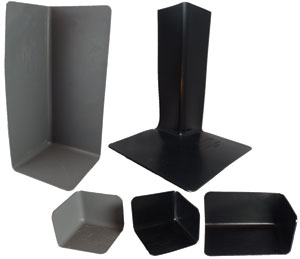Moisture Management in Masonry Buildings
Adhesives
There are numerous adhesives on the construction market. To assure compatibility with the flashing materials, the adhesive should be selected and purchased along with the flashing components. Non-curing butyl or synthetic rubber is the most common form of adhesive. This material will stick to almost any surface and never completely hardens, so it will move along with the building.
 |
Compatible corner boots and end dams can be specified with a unitized flashing system manufactured to meet many sizes and configurations of a modern wall system. Photo by Mortar Net® USA, Ltd. |
Polyether sealants are new to the wall flashing industry but have been tested and used in the roofing industry. Polyether sealants can be applied in temperatures as low as 30 degrees F, extending the construction cycle. They are made without any volatile organic solvents, and contain no carcinogenic materials. They conform to California's proposition 65 and according to an article in Roofing Contractor, “These are the most environmentally and OSHA-compliant sealants on the market today.”4
End Dams, Penetrations, and Corner Details
Masons install end dams at the ends of lintels and masonry openings. There are left and right end dams as well as universal units that can be used in any configuration. Overlooking the inclusion of an end dam may result in field ordering of these components on-site by the mason. The material in an end dam must be compatible with the flashing membrane and adhesives. The end dams prevent water from moving laterally through the mortar that can cause spalling and joint failure in the masonry adjacent to the openings.
All penetrations through exterior walls require flashing particularly those that intersect the line of the flashing at the bottom of walls. With a system that can be easily cut and placed over the pipe, extrusion or other protruding object and then taped, a solid moisture barrier is created at a place where leaks and subsequent cracking of the masonry can occur.
Proposition 65, the Safe Drinking Water and Toxic Enforcement Act of 1986, was enacted as a ballot initiative in November 1986. The Proposition was intended by its authors to protect California citizens and the state’s drinking water sources from chemicals known to cause cancer, birth defects, or other reproductive harm, and to inform citizens about exposures to such chemicals. Proposition 65 requires the Governor to publish, at least annually, a list of chemicals known to the state to cause cancer or reproductive toxicity.5 |
Masonry corners can provide challenges for flashing installations. Rather than piecing together flashing fabrics and wrapping them around the edges or corners in two directions new products include different sizes of corner boots. With a manufactured corner boot, the flashing is set upon the wall, adhered to the substrate and can extend above the flashing to avoid lateral moister penetrations at the corners. Masonry corner boots can be specified to have taller profiles and are available for radial corner conditions.
Concrete Masonry Units (CMU) Construction
Single wythe concrete masonry walls also need protection from water damage. In the case of a single wythe system, water will run down the inside of the block and can cause the deterioration of steel reinforcement and wall failure. By placing flashing at wall openings and above the base of the wall, water can expelled out to the face of the building preventing damage to the masonry wall. A unitized system requires no additional components except for sealant and includes the following:
- Vertical mesh components that prevent mortar droppings from blocking pathways to the exterior of the building.
- Vertical mesh components and weep tabs to provide open pathways for water to migrate to the exterior of the building.
- A rear dam on the stainless steel drainage strips channels water to the weep tabs and out of the building.
- Forms a continuous drainage system around the entire perimeter of a concrete block building.
- Installs quickly and easily with minimal training.
- May be used with 6-inch block and larger.
- May be used over wall openings, bond beams and structural steel members if ends are properly dammed.









